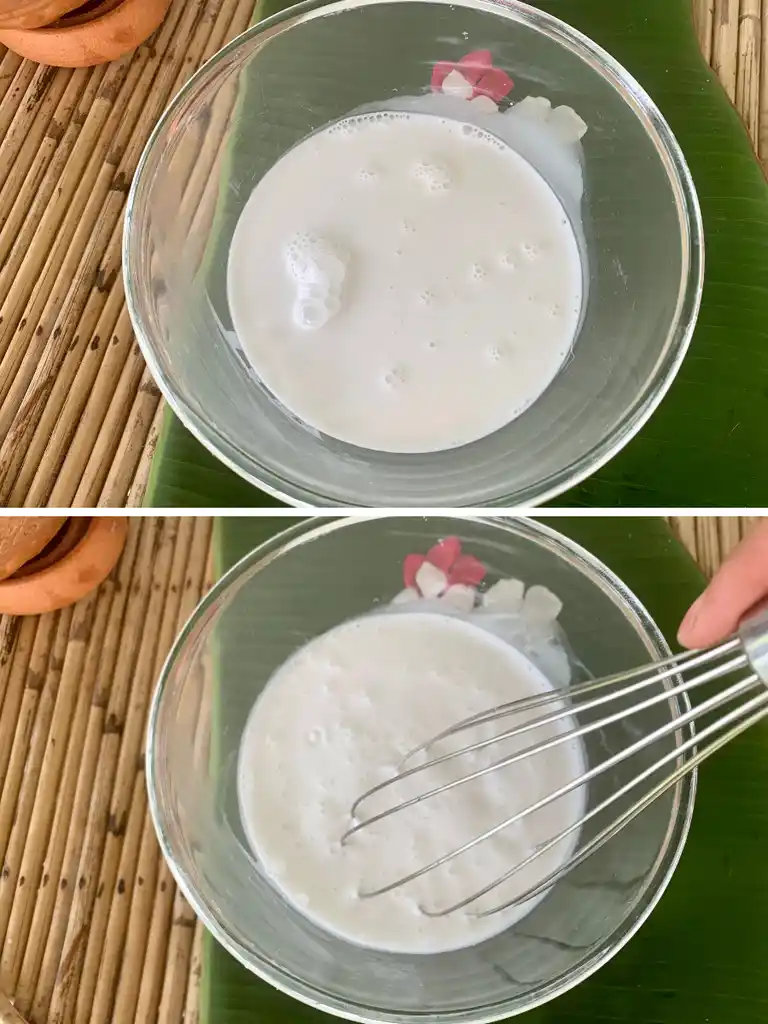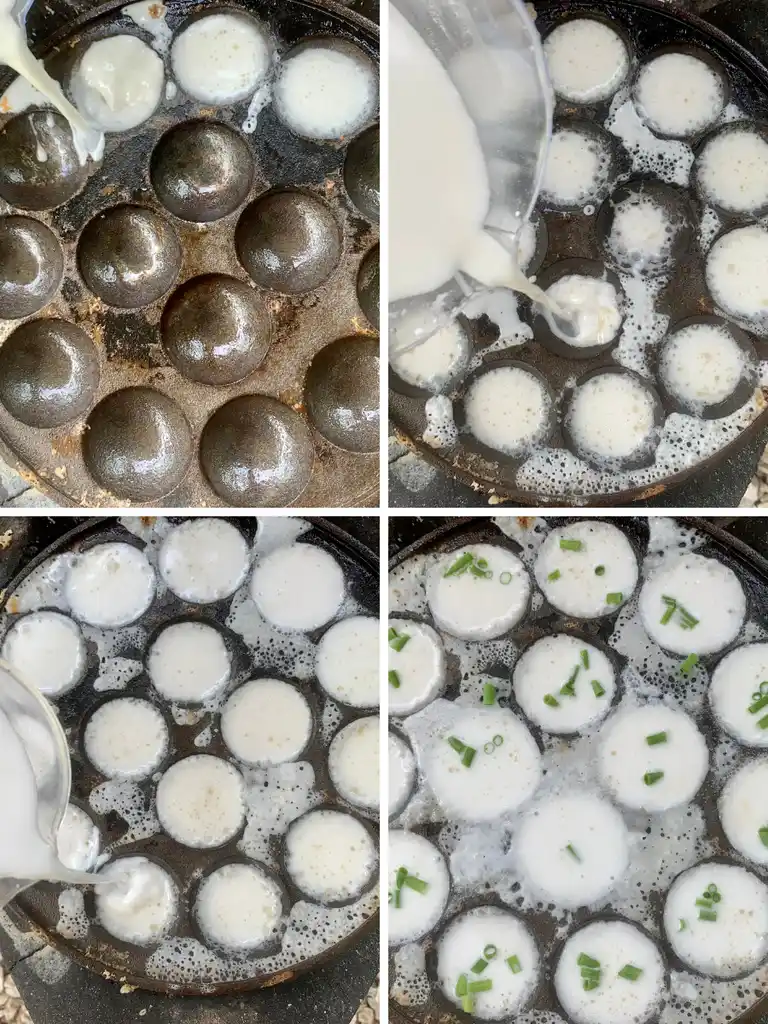This easy kanom krok recipe brings you the best Thai coconut pancakes—crispy, sweet, and creamy! Made with rich coconut milk and cooked in a hot pan, they’re foolproof and turn out perfectly every time.

Quick tip: If you love these cute tiny treats, you’ve got to try roti next! It’s another Thai pancake that’s a street food staple in Thailand.
Kanom krok is a traditional Thai dessert made from rice flour and coconut milk, cooked in a special pan with small round molds. These mini pancakes have a crispy exterior and a soft, custard-like center, and can be topped with many different toppings for added flavor.

Recipe highlights
- Dairy & gluten-free: 100% family-friendly and perfect for anyone avoiding dairy or gluten.
- Endless toppings: You can mix and match toppings however you like—corn, taro, or even something unique like cheese or nuts.
- Great for any time: These are perfect to make with the kids on a lazy weekend, whether you like them for dessert or a tasty snack throughout the day!
- Easy Instructions: The detailed instructions with images will have you making these coconut milk pancakes like a Thai chef.
- Street food at home: Making this dessert will make your kitchen smell like a Bangkok street market, and they’re easier than you think—promise!

If you love desserts with coconut milk as much as I do, make sure to try some of my favorites: pandan coconut jelly and bua loy!
What is the best kanom krok pan?
The right pan makes all the difference when it comes to these coconut pancakes. It’s what gives them that crispy bottom and creamy center. I’ve got two great recommendations for you—both can be found online or at an Asian supermarket.
Cast iron pan
This is the traditional choice—the kind you’d see at street food markets in Thailand. Made from cast iron, it evenly distributes heat, giving each pancake its signature crispy bottom. If you’re lucky enough to find one, make sure it’s heavy (cast-iron heavy) and well-made. The lighter ones don’t hold heat as well, and that’s key to getting the texture right. Get it on Amazon.
A cast iron takoyaki pan works just as well for home cooking and is a lot cheaper!

Don’t forget to season: If you’re using a cast iron pan, it needs to be seasoned before you start. I usually heat mine up over charcoal until it’s smoking, fill each mold with a high-smoke point oil (like canola oil or vegetable oil), and let it sit for an hour. This makes sure nothing sticks and everything crisps up perfectly.
Takoyaki pan
For an easier option, an electric takoyaki pan works great too! It’s non-stick, so no seasoning is needed. Just plug it in, set the temperature, and you’re good to go.
Note: While browsing on Amazon, I came across two similar pans that are worth a try: a Danish Aebleskiver pan and a Dutch poffertjes pan!
Ingredient notes
You can pick up everything you need from your nearest Asian grocery store or Asian market. For exact measurements, don’t forget to check the recipe card at the end of this post!

Batter
- Coconut milk – Use high-quality full-fat coconut milk like Aroy-D for both the batter and filling (not coconut cream).
- Rice flour – Provides structure, keeping the pancakes light and crisp (not glutinous rice flour).
- Water – Binds the ingredients together.
- Palm sugar
- Salt
Coconut milk filling
- Coconut milk – Creates a creamy, custard-like filling that melts in your mouth.
- White sugar
- Salt
Optional garnishes
- Toasted coconut flakes
- Chopped green onions
- Toasted sesame seeds
- Fresh coconut shreds
- A drizzle of honey
- Chocolate chips
Step-by-step instructions
Make the batter

Step 1: In a large mixing bowl, pour in the water and add the rice flour.
Step 2: Let the mixture sit for 20 minutes.
Step 3: Knead the mixture until completely smooth and free of lumps.
Step 4: Add the coconut milk, palm sugar, and salt. Continue kneading until the palm sugar dissolves completely.
Make the coconut filling

Step 5: In another bowl, whisk together the coconut milk, white sugar, and salt until smooth.
Cook pancakes

Step 6: Preheat your pan. If using a cast iron pan, heat it over charcoal. If using a stovetop pan, heat it over medium heat.
Step 7: Brush a light layer of oil into each mold. Stir the batter and fill each mold about two-thirds full, starting from the outer edge and working towards the center.
Step 8: Once the batter is in, stir the coconut filling and spoon it on top of each mold.
Step 9: Sprinkle chopped green onions or your desired topping over each pancake.
Step 10: If possible, cover the pan with a lid to trap the heat. This helps cook the pancakes evenly and ensures a crispy bottom and set filling.
Step 11: Once cooked, use a small spoon to gently lift the kanom krok out of the pan. Serve them warm, fresh off the pan, when they’re crispy on the outside and creamy inside.
Kitchenware
- Measuring cups and spoons
- Two mixing bowls: One for the batter, one for the filling.
- Whisk
- Kanom krok pan
- Heat-resistant cooking brush: For greasing the pan.
- Pouring jug: To easily pour the batter and filling into the pan.
- Spoon: For flipping or removing the pancakes from the pan.
Recipe tips and tricks
- Cook over medium heat: This ensures your pancakes don’t burn (if too high) or lack crispiness (if too low). You can start with one pancake as a test.
- Taste-test: Starting with a test pancake allows you to adjust the flavors in your batter and filling. Aim for a balance of creamy, sweet, and subtly salty flavors.
Did you know? The Lao name for this dessert is khao nom kok, and it’s packed with the same irresistible coconut-filled goodness!
Kanom translates to candy or dessert, while krok means mortar. It’s unclear if the batter was originally made using a mortar and pestle—even my Thai grandmother couldn’t confirm it!
How to store coconut milk pancakes
- Storing: Let the pancakes cool completely before placing them in an airtight container. Use parchment paper to separate the layers, and store in the fridge for up to 2 days.
- Reheating: Warm them in the oven or the kanom krok pan, or enjoy cold.
- Make ahead: The batter and filling can be made a day ahead and kept in the fridge.
More Thai coconut dessert recipes you’ll love!
- Tub tim krob (Thai red rubies, calls for tapioca starch)
- Khao lam (sticky rice in bamboo)
- Khanom chan (Thai layer cake)
- Khanom tom (coconut balls)
- Thai coconut custard
- Ruam mit
Loved reading this kanom krok recipe? Please make my day by dropping a star rating and/or a comment below! Follow me on social media: Facebook, Instagram, and Pinterest.
Kanom Krok Recipe (Authentic Thai Coconut Pancakes)

Ingredients
For the batter
- 10 oz or 2 1/4 cups rice flour
- 4 1/4 cups water
- just under 1/4 cup coconut milk
- 1/2 cup palm sugar
- 1/2 teaspoon salt
For the coconut filling
- 1 2/3 cups coconut milk
- 2 tbsp white sugar
- 1 teaspoon salt
Instructions
Make the batter
- In a large mixing bowl, pour in the water and add the rice flour.
- Let the mixture sit for 20 minutes.
- Knead the mixture until completely smooth and free of lumps.
- Add the coconut milk, palm sugar, and salt. Continue kneading until the palm sugar dissolves completely.
Make the coconut filling
- In another bowl, whisk together the coconut milk, white sugar, and salt until smooth.
Cook pancakes
- Preheat your pan. If using a cast iron pan, heat it over charcoal. If using a stovetop pan, heat it over medium heat.
- Brush a light layer of oil into each mold. Stir the batter and fill each mold about two-thirds full, starting from the outer edge and working towards the center.
- Once the batter is in, stir the coconut filling and spoon it on top of each mold.
- Sprinkle chopped green onions or your desired topping over each pancake.
- If possible, cover the pan with a lid to trap the heat. This helps cook the pancakes evenly and ensures a crispy bottom and set filling.
- Once cooked, use a small spoon to gently lift the kanom krok out of the pan. Serve them warm, fresh off the pan, when they’re crispy on the outside and creamy inside.
Notes
- Use the nutrition card in this recipe as a guideline.
- For this recipe, you'll need a kanom krok pan. You can purchase one online at Amazon. For more information, see the recipe under 'kanom krok pan'.
- The batter and toppings can be prepared a day in advance and stored in the fridge.







kanom krok is my favorite thai dessert. this guide is very detailed. will make it for sure when i have the time!!
Thank you for taking the time to drop a comment, enjoy!